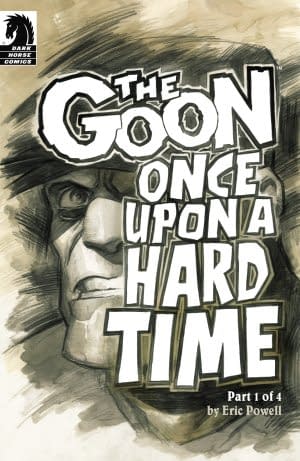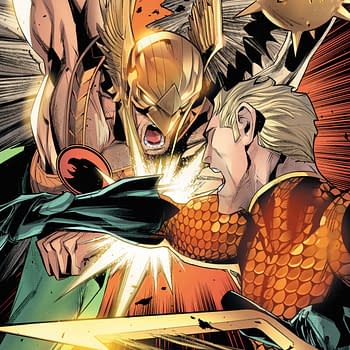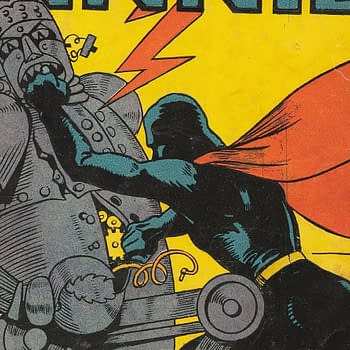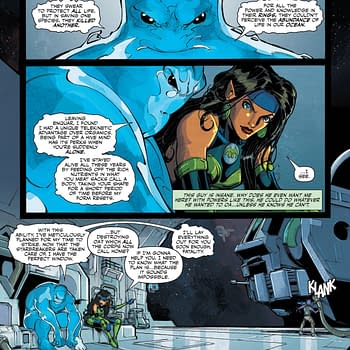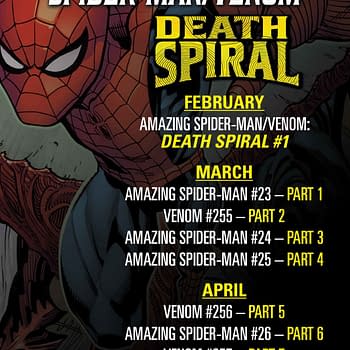Posted in: Comics, Recent Updates | Tagged: Action Comics #39, dark horse comics, dc comics, eric powell, grant morrison, image comics, Nameless #1, Superman #38, The Goon: Once Upon A Hard Time #1
Thor's Comic Review Column – Superman #38, Action Comics #39, Nameless #1, The Goon: Once Upon A Hard Time #1
This Week's Reviews:
Superman #38
Action Comics #39
Nameless #1
The Goon: Once Upon A Hard Time #1
Superman #38 and Action Comics #39 ($4.99 & $3.99, DC)
By D.S. Randlett (@dsrandlett)
In a way, I guess that I should be thankful to DC Comics every time they try to do something new with Superman, and just screw it up. After events like Reign of the Supermen, Superman Blue, or Infinite Crisis, there's usually something of a reaction afterwards where a new creative team goes all in on what makes the character work. I keep thinking of the post Infinite Crisis story, Up, Up, and Away by Kurt Busiek, Geoff Johns, and Pete Woods as a touchstone, where the approach wasn't so much to reboot everything in the continuity as much as it was to refocus on what Superman stands for, which had gotten somewhat lost in the years since the original Crisis in the midst of the soap operatics of the Lois and Clark marriage and the hugeness of the Silver Age tribute that was the Loeb era. Despite the character's growing power set during the post-Crisis era, many writers would lose sight of the heart that made those Silver Age stories so worthwhile despite their kookier indulgences.

The core Superman books, Action and Superman, feel like they've been rebuilding for some time after the mess that was the Lobdell run. This was particularly true of the Doomed event, which wrapped up all of the threads from that run in a rather satisfying way. In the aftermath, we've had the continuing Pak/Kuder run, and the arrival of Geoff Johns and John Romita, Jr. to Superman. This week, the Superman rehabilitation project continues with two stories that focus on very different but equally key aspects of the character.
In Action, Pak is joined by Scott Kolins to wrap up the Horrorville arc. I was lukewarm on this story at first, but it quickly evolved into something more, much like Pak's first full arc on the title. The finale carries over some of the themes from Doomed in a quite satisfying way, while pushing Pak's examination of Clark Kent forward. Here, Kent must face the fact of mortality, if not his own, then everyone else's. In order to defeat a creature from the Phantom Zone that feeds on personal horror, Superman must face what he really fears. It's a story that works on all sorts of metaphorical levels, from Superman ripping off a suit that inhibits his emotion to the emotional climax where Superman has to face a future where he's well and truly alone. Where previous iterations of the character have known about his impact thanks to frequent team ups with the Legion of Superheroes, it's refreshing to see a Superman who doesn't know whether or not he's going to have the impact that he wants to have. It also makes Superman's choosing to represent what he does all the more profound. He's a protector not only of lives, but of a delicate future.

In and of themselves, these issues are fine comics, but thankfully they seem to portray a publisher willing to let the creative teams on these books reclaim Superman's moral center.
D.S. Randlett lives in the hills of Virginia and takes credit for the reviews that his emaciated twin brother writes while chained to the old radiator. He plays his guitar while biding his time for unsuspecting tourists and thinking about going to grad school.
Nameless #1 (Image, $2.99)
By Cat Taylor

The second reason I bought the first issue of Nameless was for the writing of Grant Morrison. To me, Morrison is a bit like Forrest Gump's box of chocolates. When he writes something I like, such as Animal Man or All-Star Superman I think he's the greatest comic book writer ever. On the other hand, some of his highly praised work like Doom Patrol or Invisibles just doesn't do it for me. I'm not saying they're bad books, but they just don't register with me and sometimes his stuff is so out there that I just end up confused and wonder if I'm missing something deeper or he's being intentionally vague and weird for weirdness' sake. Sometimes a story that doesn't follow norms and doesn't have a clear interpretation can be awesome in its own right. Some of David Lynch's movies are like that, but once again, some of the weird Morrison comics just don't hit those appreciation buttons with me. Regardless, I decided that the combination of Morrison with such a cool cover image was worth taking a chance. The verdict? I'm glad I did…for now. I can see this series going either way though.
I'm not sure how much I should say about the story. There are no big surprise twists or anything like that where I have to announce spoiler alerts, but since the marketing of the book has been kept intentionally vague, I have to assume that the creators and/or Image wanted to keep it that way. One thing that they did communicate though was that this is a horror comic. Considering that just two weeks ago I spent the better part of a review for this column talking about how most horror comics don't deliver, it seems ironic that I've found one that kind of does this soon after saying all that. In addition to giving the creators a lot of credit for success in that area, I also have to credit the inclusion of dreamworlds similar to the movies, Inception and Dreamscape for part of that success.
It's unusual for me to add a new title to my regular holds, but I'm going to stick with Nameless and see where it goes. There's a lot of potential here and want to see if it holds up.
Cat Taylor has been reading comics since the 1970s. Some of his favorite writers are Alan Moore, Neil Gaiman, Peter Bagge, and Kurt Busiek. Prior to writing about comics, Taylor performed in punk rock bands and on the outlaw professional wrestling circuit. During that time he also wrote for music and pro wrestling fanzines. The restaurant he's sitting at is about to close. So, he has not time to think of a witty tag line to put here. You can e-mail Taylor at cizattaylor@hotmail.com.
The Goon #50: Once Upon A Hard Time #1 of 4 (Dark Horse)
By Jeb D.
For the past decade or so, Eric Powell's The Goon has been a regular source of ghoulish humor, two-fisted action, and stunning comic book art. Powell, one of the few writer-artist combos today working in a genre with at least tangential relation to the superhero comic, has crafted a world and cast of characters that blends the lack of inhibition of Kurtzman's MAD with the grungy salaciousness of the 70's-era National Lampoon cartoon section and a gleeful, unabashed brutality; his art is like Jack Davis hopped up on Kirby, with a dash of Colan for mood: Hellboy with no sense of decorum.
Over the past few years, though, it was easy to lose track of the series, as the pressure of turning out a book as painstaking as The Goon on a regular schedule proved difficult for Powell. At the end of issue #44, the last regular in-continuity issue of the series, he announced that The Goon would move to a mini-series format (though technically retaining the Dark Horse numbering). The following year saw the four-part Occasion of Revenge mini, and it certainly seemed that more than time pressure had borne down on Powell in the interim. Though his graphic novel Chinatown and the Mystery of Mr. Wicker had experimented with changing The Goon's mixture, shifting the tone even further towards crime than humor or horror, and injecting doses of romance, Occasion of Revenge was a starkly different vision of The Goon, borrowing even more heavily than usual from classic noir, with a brutality reminiscent of Donald Westlake or Jim Thompson.
Dark Horse issue #50 of The Goon begins Once Upon A Hard Time, which is, in effect, the four-part continuation of Occasion of Revenge, and if we thought that the previous series was rough going, the first issue of this one is positively suffused with hopelessness. Occasion of Revenge saw The Goon revealed as surprisingly vulnerable, and not just to the numerical superiority of his ghastly foes. Once Upon A Hard Time opens in the wake of Occasion of Revenge, with The Goon on a drunken rampage. His plan to enlist mob help against The Magpies has backfired, and at this point, The Goon appears to have little hope of achieving anything but vengeance. No jokes, no celebrity-cameo diversions; the script is brutally straight-ahead, and the foreshadowing of doom isn't subtle: Powell as much as tells us that The Goon will be undone by the weakness of those around him. In the current state of things in The Goon, the classic conservatism of the horror and crime genres comes through more clearly than ever: sex leads inevitably to disaster, and the only women featured in the story so far are a heartless gold digger and a literal harpy. In place of the cartoony monsters of The Goon's early days, there's a noir-ish purity to the evil portrayed now: its sole interest is power for its own sake. The town has nothing of intrinsic value (in any real-world sense, the place would be an outright liability); all it can offer is the chance to possess and corrupt its denizens.
As the events of the story have borne down on The Goon, so has Powell's color palette ratcheted down: where Occasion of Revenge used occasional bursts of garish color to punctuate its action, this issue is told almost completely in bleak washes of grey and sepia (with touches of bilious green to emphasize the rot at its core), the layout stark and rigid.
Powell has indicated that this series will be the end of The Goon, as we know it (if not necessarily of The Goon himself), and it is pretty hard to imagine going back to the merry madness of devil babies and lovestruck sea monsters after this. And Frankie has never felt more like Powell's id when he laments "I'm losing my friend and I'm tired of watching him hurt. Maybe it's better if he does die."
If dark and doom-laden noir, with lashings of the macabre, is your thing… well, you're still about seven hells removed from the misery that Powell is putting The Goon through here.
Jeb D has an ugly jump shot, but it goes in. Usually.


